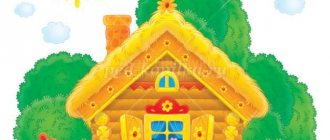Astronomy for children > Solar system > Planet Earth
Everything about planet Earth for children: how it appeared and was formed, interesting facts, what the structure is made of in photos and drawings, the rotation of the Earth, the Moon and life.
start a story about Earth for the little ones with the fact that we live on the third planet from the Sun. Parents or teachers at school had to explain to the children that they were very lucky. After all, the Earth is so far the only known planet in the solar system that contains an atmosphere with oxygen, liquid oceans on the surface and life.
If we consider by size, then we occupy fifth place (less than Jupiter , Saturn , Uranus and Neptune , but more than Mercury and Venus ).
The diameter of planet Earth is 13,000 km. It is circular in shape because gravity pulls in matter. Although this is not a perfect circle, because rotation causes the planet to compress at the poles and expand at the equator.
Water occupies approximately 71% (most of it is oceans). 1/5 of the atmosphere consists of oxygen, which is produced by plants. While scientists have been studying the planet for centuries, spacecraft have made it possible to look at it from space. Below, schoolchildren and children of all ages will be able to consider interesting facts about the Earth and receive a full description of the third planet from the Sun with photos and pictures. But it should be recalled that the Earth has a class, or rather a planetary type - a rocky body (there are also ice and gas giants that differ in characteristics).
Characteristics of the Earth's orbit - explanation for children
To give a complete explanation for children , parents must unpack the concept of axis. This is an imaginary line running through the center from the North to the South Pole. It takes 23.934 hours to complete one revolution, and 365.26 days (Earth year) to orbit around the Sun.
The tilt of the earth's axis and the movement of the planet throughout the year
Children should know that the Earth's axis is tilted relative to the plane of the ecliptic (the imaginary surface of the Earth's orbit around the Sun). Because of this, the northern and southern hemispheres sometimes rotate and face away from the Sun. This leads to a change in seasons (the amount of light and heat received changes).
The Earth's orbit is not a perfect circle, but an oval ellipse (this is common to all planets). It approaches the Sun in early January and moves away in July (although this has less effect on heating and cooling than the tilt of the Earth's axis). should be explained to children . This is the distance that allows the temperature to maintain water in a liquid state.
Highest point
Interesting fact about the highest point.
Mount Everest is not technically the highest point on Earth. Since the Earth is not perfectly round, objects located near the equator are slightly "higher" or closer to space than objects located further from the equator. Thus, Mount Chimborazo in Ecuador is 2,743 meters lower than Everest, measured from sea level. However, due to the "bulge" of the equator, its summit is actually about 2,400 meters further from the center of the Earth than the summit of Everest.
The formation and evolution of the Earth - an explanation for children
The explanation for children will remain incomplete if the description of the Earth bypasses prehistory. Researchers believe that the Earth formed along with the Sun and other planets 4.6 billion years ago. Then the Solar system was reunited with a huge gas and dust cloud - the solar nebula. Gravity gradually destroyed it, giving it more speed and a disk shape. Much of the material was drawn to the center and began to form the Sun.
Other particles collided and combined to form larger bodies. The solar wind was so powerful that it managed to dislodge lighter elements (hydrogen and helium) from the most distant worlds. This is why the Earth and other planets became rocky.
In early history, planet Earth may seem like a lifeless piece of rock to children. Radioactive materials and pressure rising from the depths provided enough heat to melt the interior. This caused some chemicals to splash out to form water, while others became atmospheric gases. According to recent data, the crust and oceans could have appeared 200 million years after the formation of the planet.
Children should know that earthly history is divided into 4 eons: Hadean, Archean, Proterozoic and Phanerozoic. The first three took almost 4 billion years and are collectively called the Precambrian. Evidence of life was discovered in the Archean about 3.8 billion years ago. But life was not rich until the Phanerozoic.
The Phanerozoic period is divided into 3 eras: Paleozoic, Mesozoic and Cenozoic. The first demonstrated the emergence of many varieties of animals and plants in the seas and on land. The Mesozoic provided dinosaurs, but the Cenozoic is literally our era (mammals).
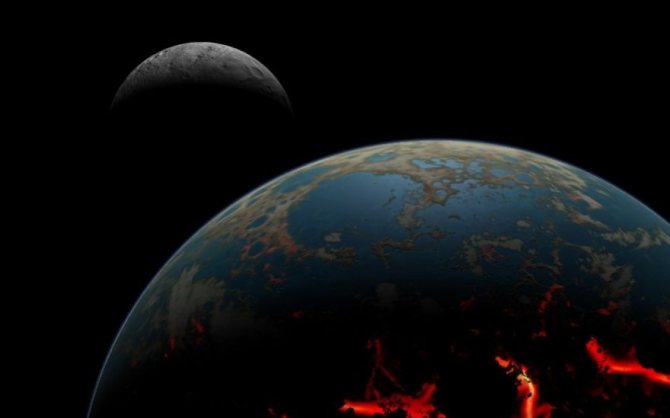
Hypothetical view of the planet 3 billion years ago
Most fossils from the Paleozoic are invertebrate animals (corals, trilobites and mollusks). Fish fossils have been dated back to 450 million years ago, and amphibians to 380 million years old. Vast forests, swamps and early reptiles inhabited the Earth 300 million years ago.
The Mesozoic was the period in which dinosaurs lived. Although mammal fossils were also 200 million years old. During this period, flowering plants seized power (and continue to do so today).
The Cenozoic era began about 65 million years ago, when the dinosaurs became extinct (scientists attribute this to cosmic influences). Mammals managed to survive, and they became the main creatures on the planet.
The composition and structure of the Earth - an explanation for children
Atmosphere
Composition: 78% nitrogen and 21% oxygen with small admixtures of water, carbon dioxide, argon and other gases. Nowhere else in the solar system will you find an atmosphere filled with free oxygen. But this is exactly what turned out to be important for our lives.
The earth is surrounded by air, becoming thin as it moves away from the surface. At an altitude of 160 km, it is so thin that satellites have to overcome only minor resistance. But traces of the atmosphere are still found at an altitude of 600 km.
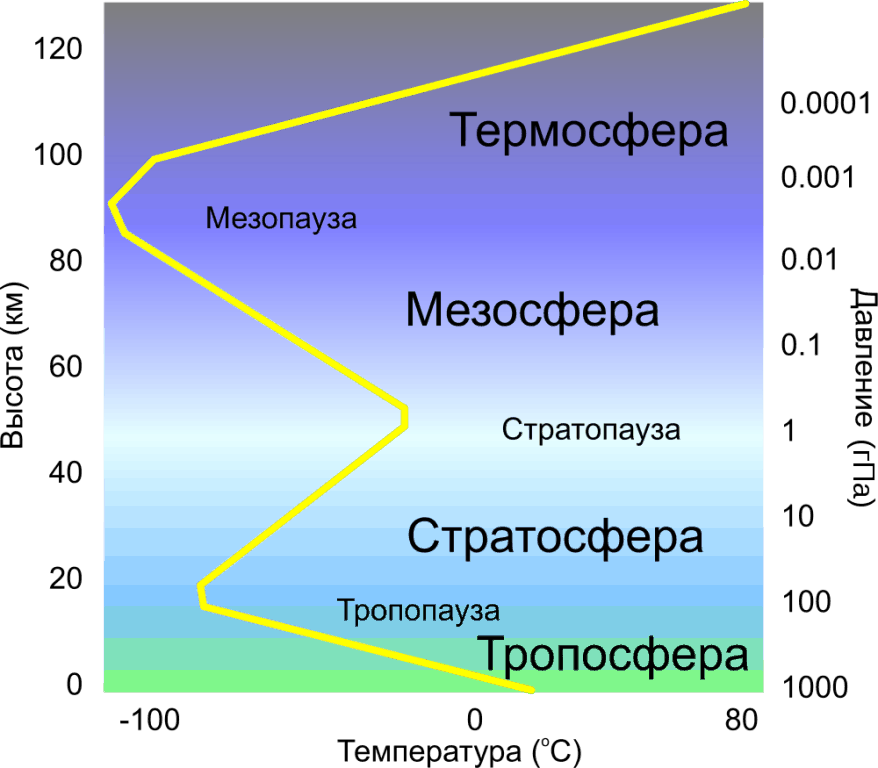
The structure of the Earth's atmosphere
The lowest layer of the atmosphere is the troposphere. She does not stop moving and is responsible for weather conditions. Sunlight heats the atmosphere, creating a warm air current. It expands and cools as pressure decreases. Children need to understand that cold air becomes denser, so it sinks down to warm the lower layers.
The stratosphere is located at an altitude of 48 km. This is a stationary ozone layer created by ultraviolet light causing a trio of oxygen atoms to form the ozone molecule. for the little ones to know that it is ozone that protects us from most of the dangerous ultraviolet radiation.
Carbon dioxide, water vapor and other gases trap heat and warm the Earth. If it were not for this “greenhouse effect,” the surface would be too cold and would not allow life to develop. Although the wrong greenhouse could turn us into a hellishly hot version of Venus.
Satellites in Earth orbit have shown that the upper atmosphere expands during the day and contracts at night due to heating and cooling processes.
A magnetic field
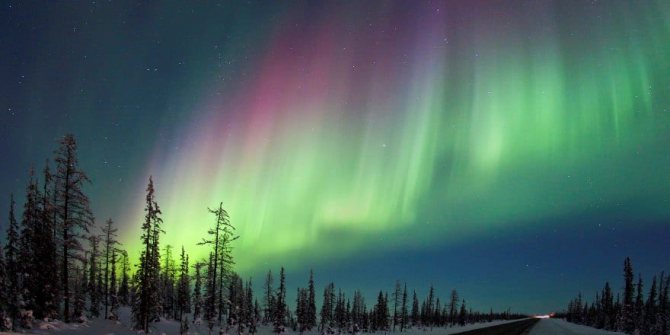
The Northern Lights (polar) are caused by the interaction between the solar wind and the Earth's magnetic field.
The Earth's magnetic field is created by currents emanating from the outer layer of the earth's core. Magnetic poles are always moving. The magnetic north pole accelerates movement up to 40 km per year. In a few decades, it will leave North America and reach Siberia.
NASA believes the magnetic field changes in other directions as well. Globally it has weakened by 10%, measured since the 19th century. Although these transformations are insignificant if you delve into the distant past. Sometimes the field completely flipped, reversing the north and south poles.
When particles charged by the Sun find themselves in a magnetic field, they break up into air molecules above the poles and create the northern and southern lights.
Chemical composition
The most common element in the earth's crust is oxygen (47%). Next come silicon (27%), aluminum (8%), iron (5%), calcium (4%), and 2% each of potassium, sodium and magnesium.
The Earth's core consists mainly of nickel, iron and lighter elements (sulfur and oxygen). The mantle is made of silicate rocks rich in iron and magnesium (a combination of silicon and oxygen called silica, and materials containing it are called silicate).
Internal structure
Schoolchildren and children of all ages should remember that the Earth's core is 7,100 km wide (a little more than half the Earth's diameter and roughly the size of Mars). The outermost layers (2250 km) are liquid, but the inner one is a solid body and reaches 4/5 the size of the Moon (2600 km in diameter).
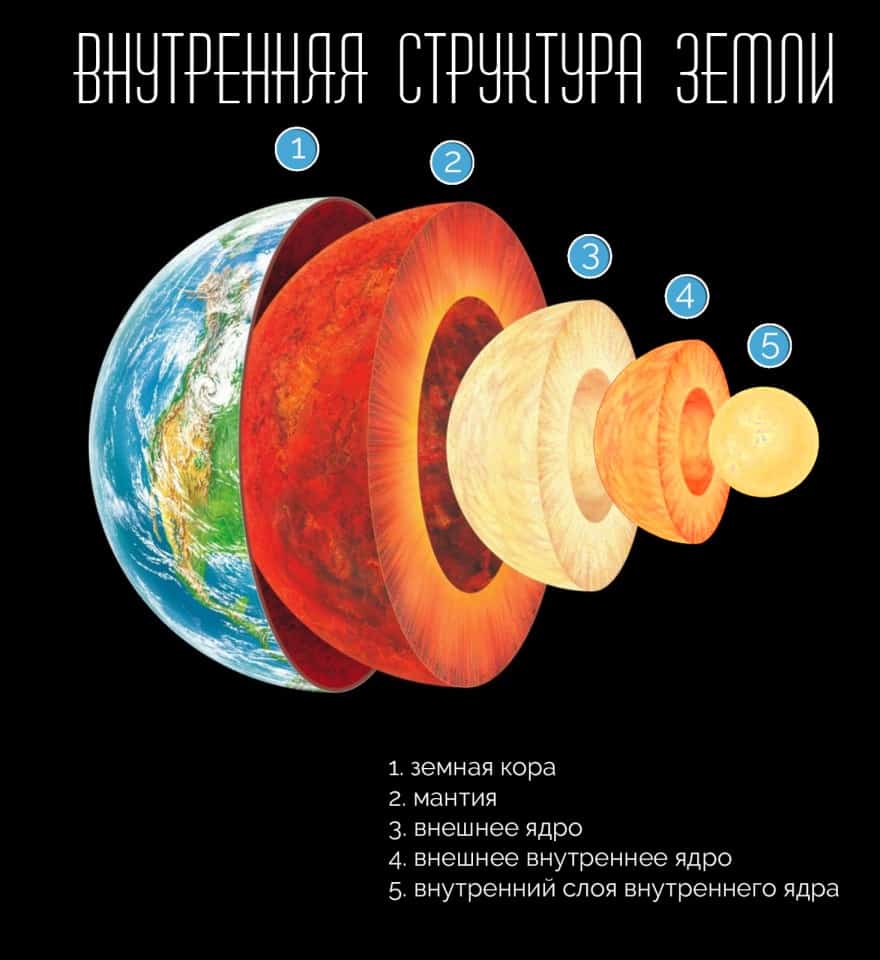
Internal structure of the Earth
Above the core is a mantle 2900 km thick. Children may have heard at school that it is not completely hard, but can flow very slowly. The Earth's crust floats across it, causing the continents to shift almost imperceptibly. True, people realize this in the form of earthquakes, erupting volcanoes and the formation of mountain ranges.
There are two types of earth's crust. The landmass of the continents consists mostly of granite and other light silicate minerals. The ocean floors are dark and dense volcanic rock - basalt. The continental crust is up to 40 km thick, although it may vary depending on the specific area. The oceanic one grows to only 8 km. Water fills low areas of basalt and forms the world's oceans. The Earth has a lot of water, so it completely fills the ocean basins. The rest reaches the edges of the continents - the continental plume.
The closer to the core, the warmer it is. At the very bottom of the continental crust, temperatures reach 1000 °C and increase by 1 °C with every kilometer down. Geologists suggest that the outer core is heated to 3700-4300 °C, and the inner core - 7000 °C. This is even hotter than the surface of the Sun. Only enormous pressure allows its structure to be preserved.
Recent exoplanet studies (such as NASA's Kepler mission) suggest that Earth-like planets are found throughout our galaxy. Almost a quarter of observed solar stars may have potential habitable Earths.
Interesting facts about the planets of the solar system
Our Universe is a huge field for study. There are many interesting facts about the planets, some of them are widely known, others are not. Over time, humanity is learning more and more new facts about planets and other cosmic bodies.
Here are some interesting facts about planets :
- There are at least 5 dwarf planets, including Pluto.
- Venus rotates in the opposite direction from the movement of all the planets.
- The Great Spot on Jupiter is a giant storm that changes its direction and size over several centuries.
- Neptune has winds of 2100 km/h.
- Venus is considered the brightest planet. It is also called the Morning and Evening Star.
- It has been proven that the Sun is not the largest star. The Sun is one of the 200 billion stars in the Milky Way.
- Earth is the only planet not named after gods.
- Scientists suggest that if all the ice caps of Mars were melted, water would cover the entire planet.
- Jupiter has enormous gravitational force. It attracts all space objects flying nearby.
- The highest mountain in the solar system is an extinct volcano on Mars. Its height is more than 21 km.
You can continue endlessly. Astronomy does not stand still; thanks to progress, scientists discover new cosmic bodies, obtain information about their structure, surface and other important characteristics. And we, in turn, can learn more and more interesting facts and news from the world of space.
Earth's Moon - explanation for children
Children should not forget that the Earth has a faithful satellite - the Moon. It reaches a width of 3474 km (about a quarter of the Earth's diameter). Our planet has only one satellite, although Venus and Mercury do not have them at all, and some have two or more.
The moon was formed after a giant object crashed into the Earth. The torn off debris became the constituent material of the Moon. Scientists believe the object was roughly the size of Mars.
| Moon |





